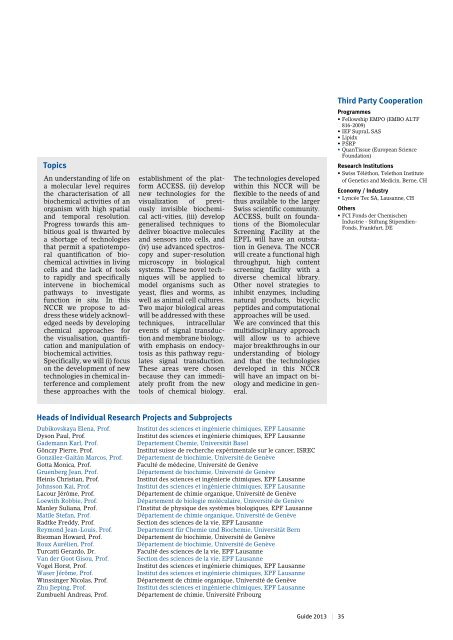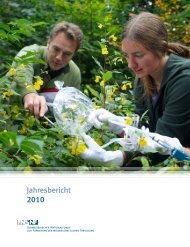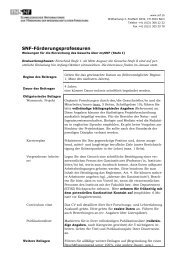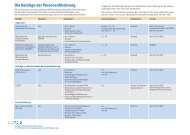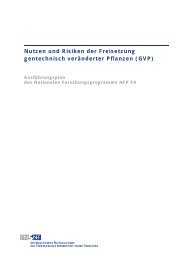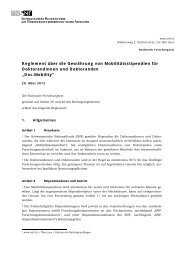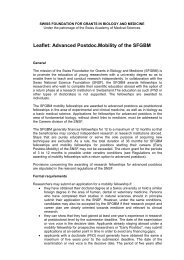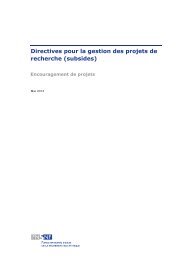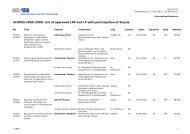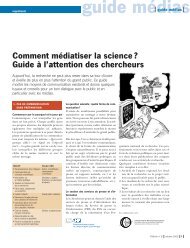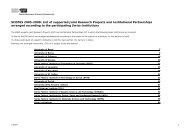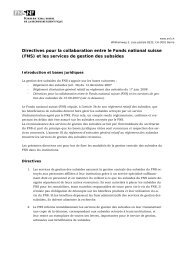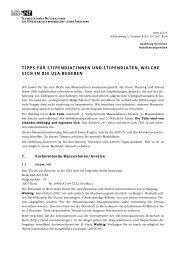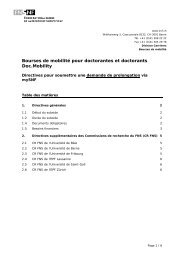NCCR Guide 2013 - Schweizerischer Nationalfonds (SNF)
NCCR Guide 2013 - Schweizerischer Nationalfonds (SNF)
NCCR Guide 2013 - Schweizerischer Nationalfonds (SNF)
Create successful ePaper yourself
Turn your PDF publications into a flip-book with our unique Google optimized e-Paper software.
Third Party Cooperation<br />
Topics<br />
An understanding of life on<br />
a molecular level requires<br />
the characterisation of all<br />
biochemical activities of an<br />
organism with high spatial<br />
and temporal resolution.<br />
Progress towards this ambitious<br />
goal is thwarted by<br />
a shortage of technologies<br />
that permit a spatiotemporal<br />
quantification of biochemical<br />
activities in living<br />
cells and the lack of tools<br />
to rapidly and specifically<br />
intervene in biochemical<br />
pathways to investigate<br />
function in situ. In this<br />
<strong>NCCR</strong> we propose to address<br />
these widely acknowledged<br />
needs by developing<br />
chemical approaches for<br />
the visualisation, quantification<br />
and manipulation of<br />
biochemical activities.<br />
Specifically, we will (i) focus<br />
on the development of new<br />
technologies in chemical interference<br />
and complement<br />
these approaches with the<br />
establishment of the platform<br />
ACCESS, (ii) develop<br />
new technologies for the<br />
visualization of previously<br />
invisible biochemical<br />
acti-vities, (iii) develop<br />
generalised techniques to<br />
deliver bioactive molecules<br />
and sensors into cells, and<br />
(iv) use advanced spectroscopy<br />
and super-resolution<br />
microscopy in biological<br />
systems. These novel techniques<br />
will be applied to<br />
model organisms such as<br />
yeast, flies and worms, as<br />
well as animal cell cultures.<br />
Two major biological areas<br />
will be addressed with these<br />
techniques, intracellular<br />
events of signal transduction<br />
and membrane biology,<br />
with emphasis on endocytosis<br />
as this pathway regulates<br />
signal transduction.<br />
These areas were chosen<br />
because they can immediately<br />
profit from the new<br />
tools of chemical biology.<br />
The technologies developed<br />
within this <strong>NCCR</strong> will be<br />
flexible to the needs of and<br />
thus available to the larger<br />
Swiss scientific community.<br />
ACCESS, built on foundations<br />
of the Biomolecular<br />
Screening Facility at the<br />
EPFL will have an outstation<br />
in Geneva. The <strong>NCCR</strong><br />
will create a functional high<br />
throughput, high content<br />
screening facility with a<br />
diverse chemical library.<br />
Other novel strategies to<br />
inhibit enzymes, including<br />
natural products, bicyclic<br />
peptides and computational<br />
approaches will be used.<br />
We are convinced that this<br />
multidisciplinary approach<br />
will allow us to achieve<br />
major breakthroughs in our<br />
understanding of biology<br />
and that the technologies<br />
developed in this <strong>NCCR</strong><br />
will have an impact on biology<br />
and medicine in general.<br />
Programmes<br />
• Fellowship EMPO (EMBO ALTF<br />
816-2009)<br />
• IEF SupraL SAS<br />
• Lipidx<br />
• PSRP<br />
• QuanTissue (European Science<br />
Foundation)<br />
Research Institutions<br />
• Swiss Téléthon, Telethon Institute<br />
of Genetics and Medicin, Berne, CH<br />
Economy / Industry<br />
• Lyncée Tec SA, Lausanne, CH<br />
Others<br />
• FCI Fonds der Chemischen<br />
Industrie - Stiftung Stipendien-<br />
Fonds, Frankfurt, DE<br />
Heads of Individual Research Projects and Subprojects<br />
Dubikovskaya Elena, Prof. Institut des sciences et ingénierie chimiques, EPF Lausanne<br />
Dyson Paul, Prof.<br />
Institut des sciences et ingénierie chimiques, EPF Lausanne<br />
Gademann Karl, Prof.<br />
Departement Chemie, Universität Basel<br />
Gönczy Pierre, Prof.<br />
Institut suisse de recherche expérimentale sur le cancer, ISREC<br />
González-Gaitán Marcos, Prof. Département de biochimie, Université de Genève<br />
Gotta Monica, Prof.<br />
Faculté de médecine, Université de Genève<br />
Gruenberg Jean, Prof.<br />
Département de biochimie, Université de Genève<br />
Heinis Christian, Prof.<br />
Institut des sciences et ingénierie chimiques, EPF Lausanne<br />
Johnsson Kai, Prof.<br />
Institut des sciences et ingénierie chimiques, EPF Lausanne<br />
Lacour Jérôme, Prof.<br />
Département de chimie organique, Université de Genève<br />
Loewith Robbie, Prof.<br />
Département de biologie moléculaire, Université de Genève<br />
Manley Suliana, Prof.<br />
l‘Institut de physique des systèmes biologiques, EPF Lausanne<br />
Matile Stefan, Prof.<br />
Département de chimie organique, Université de Genève<br />
Radtke Freddy, Prof.<br />
Section des sciences de la vie, EPF Lausanne<br />
Reymond Jean-Louis, Prof. Departement für Chemie und Biochemie, Universität Bern<br />
Riezman Howard, Prof.<br />
Département de biochimie, Université de Genève<br />
Roux Aurélien, Prof.<br />
Département de biochimie, Université de Genève<br />
Turcatti Gerardo, Dr.<br />
Faculté des sciences de la vie, EPF Lausanne<br />
Van der Goot Gisou, Prof. Section des sciences de la vie, EPF Lausanne<br />
Vogel Horst, Prof.<br />
Institut des sciences et ingénierie chimiques, EPF Lausanne<br />
Waser Jérôme, Prof.<br />
Institut des sciences et ingénierie chimiques, EPF Lausanne<br />
Winssinger Nicolas, Prof.<br />
Département de chimie organique, Université de Genève<br />
Zhu Jieping, Prof.<br />
Institut des sciences et ingénierie chimiques, EPF Lausanne<br />
Zumbuehl Andreas, Prof.<br />
Département de chimie, Université Fribourg<br />
<strong>Guide</strong> <strong>2013</strong> | 35


